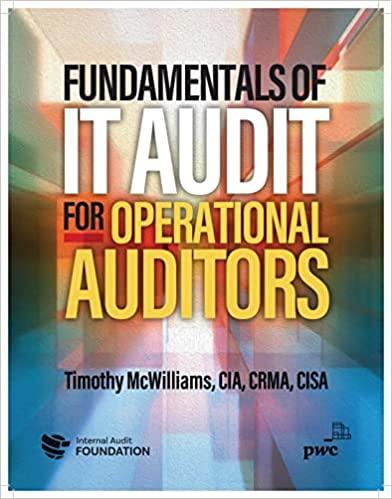Question
You are the chief accountant of a company that uses international financial reporting standards when preparing its financial reports. The chief executive officer (CEO) of
You are the chief accountant of a company that uses international financial reporting standards when preparing its financial reports.
The chief executive officer (CEO) of your company is paid a substantial bonus if the company has a pre-tax return on shareholders equity of 15%.
The CEO has told you that your job is dependent on the company achieving a pre-tax return on shareholders equity of 15% for the year about to end (beginning of year shareholders equity should be used as the denominator).
The CEO added that the company was to get an unqualified audit report and is not to break any laws.
The CEO has given you permission to use whatever accounting methods you want subject to the constraints above.
You also have permission to buy or sell non-current assets but any assets that are sold need to be replaced.
Your staff have prepared an anticipated trial balance as at the end of the year prior to any end of year adjusting entries (depreciation, accruals and prepayments, adjustments in values, etc.)
Abbreviations used in the data:
| Abbreviation | Meaning |
| BoY | Beginning of the current year |
| EoY | End of the current year |
| FV | Fair value |
| RV | Residual value |
Accounts receivable
The accounting staff have identified 25,000 of debts that have become uncollectable during the year and need to be written-off as bad. They have not written-off these uncollectable debts as they do not know how to record bad debts. The accounting staff have also prepared an aged-debtor analysis for you. The debts listed in the aged debtor analysis do not include the debts already identified as uncollectable.
Insurance, interest and customer deposits
Insurance is paid in advance. Interest is paid after it has been incurred. Some customers pay a deposit for goods before they received them. The amounts prepaid or accrued at the beginning and end of years and the cash flows associated with these items are shown in the table below.
Property, plant and equipment
The company has been using straight-line depreciation for all depreciable assets. There are no reasons to justify a change to this depreciation method. Linear interpolation can be used to estimate values of the residual value at dates between the upper and lower estimates of the useful life.
Block 1 of the land contains the companys buildings and it is only possible to sell block 1 and the buildings together. Block 2 of the land is currently vacant. It was purchased a few years ago to allow for future expansion and that expansion is scheduled to begin next year. The expanded facilities could be constructed anywhere if the company chooses to sell block 2.
The buildings useful life is dependent on the level of annual maintenance. If annual maintenance expenditure is maintained at present levels, then the useful life will be 10 years. If the level of maintenance expenditure is doubled each year then the useful life will increase to 25 years.
The level of future annual maintenance expenditure can be varied between the current amount and double the current amount with a proportional increase in useful life. Linear interpolation can be used to estimate the useful life and the residual value for the selected level of future maintenance expenditure.
There is no evidence (apart from any evidence in this data set) that the value in use of any of the assets is below the carrying amount for the asset.
Research
The CEO wants research undertaken to assess the feasibility of including new technologies in the companys manufacturing systems. The research could be undertaken by contracting an external company to conduct the research or by employing additional staff to undertake the research within the company. Either way, the research is expected to cost 15,000 and will be completed by the end of the year. The CEO is allowing you to decide whether the research is undertaken by the company or is out-sourced to an external company. The planned research expedenditure has not been recorded in the trial balance.
Dividend
The CEO plans to announce a dividend of 10,000 just before the end of the current year which will be paid next year. The formal steps to authorise the dividend are expected to be completed before end of the current year. This dividend has not been recorded in the trial balance.
Opening and closing accounts
As chief accountant, you are authorised to create or delete any ledger accounts (subject to getting an unqualified audit report and not breaking any laws).
Suspense accounts
Your accounting staff have not had extensive training in accounting. Because of this, they do not know how to account for many transactions. They have been instructed that when they come across a transaction that they do not know how to record, they are to record it in a suspense account and to give the suspense account a name that describes the transaction. It is your role, as chief accountant, to transfer the balances in the suspense accounts to their appropriate location prior to preparing financial statements.
Taxes
For simplicity, assume there are no income or transactions taxes.
Required
Prepare projected Income statement, Statement of changes in equity and Balance sheet that achieve the CEOs objective of a pre-tax return on shareholders equity of 15% while complying with the constraints described above. If you are unable to meet this objective, prepare projected financial statements that get as close to the 15% return as possible.
Step by Step Solution
There are 3 Steps involved in it
Step: 1

Get Instant Access to Expert-Tailored Solutions
See step-by-step solutions with expert insights and AI powered tools for academic success
Step: 2

Step: 3

Ace Your Homework with AI
Get the answers you need in no time with our AI-driven, step-by-step assistance
Get Started


